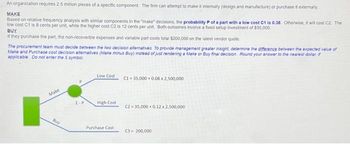
FINANCIAL ACCOUNTING
10th Edition
ISBN: 9781259964947
Author: Libby
Publisher: MCG
expand_more
expand_more
format_list_bulleted
Question
Buy P 1-P Low Cost High Cost Purchase Cost C1 = 35,000+ 0.08 x 2,500,000 C2 = 35,000+ 0.12 x 2,500,000 C3 = 200,000

Transcribed Image Text:An organization requires 2.5 million pieces of a specific component. The firm can attempt to make it internally (design and manufacture) or purchase it externally
MAKE
Based on relative frequency analysis with similar components in the "make" decisions, the probability P of a part with a low cost C1 is 0.38. Otherwise, it will cost C2. The
low cost C1 is 8 cents per unit, while the higher cost C2 is: 12 cents per unit. Both outcomes involve a fixed setup investment of $35,000.
BUY
if they purchase the part, the non-recoverble expenses and variable part costs total $200,000 on the latest vendor quote.
The procurement team must decide between the two decision alternatives. To provide management greater insight, determine the difference between the expected value of
Make and Purchase cost decision alternatives (Make minus Buy) instead of just rendering a Make or Buy final decision Round your answer to the nearest dollar, if
applicable Do not enter the $ symbol
Make
Buy
Low Cost
High Cost
Purchase Cost
C1 =35,000+ 0.08 x 2,500,000
C2=35,000+ 0.12 x 2,500,000
C3-200,000
Expert Solution
This question has been solved!
Explore an expertly crafted, step-by-step solution for a thorough understanding of key concepts.
Step by stepSolved in 3 steps

Knowledge Booster
Learn more about
Need a deep-dive on the concept behind this application? Look no further. Learn more about this topic, accounting and related others by exploring similar questions and additional content below.Similar questions
- Date Date 1/9/18 10/9/18 Dollar Rate Dollar Rate 1,16 Price in Euros Price in Dollars Price in Dollars Difference 1,18 Model 300 VRG 625 RTM 475 GRM 200 GRM 650 MTY 600 RTM 500 MTY 46.900 € $55.342 $54.404 $938 66.700 € $78.706 $77.372 $1.334 96.100 € 122.600 € 164.900 € 214.400 € 247.300 € $113.398 $111.476 $1.922 $144.668 $142.216 $2.452 $194.582 $191.284 $3.298 $252.992 $291.814 $248.704 $286.868 $4.288 $4.946 1) Most of your exports to the US belong to the model 600 RTM. The experience shows that, if the price of this product rises over 215000 dollars, the exported units will be reduced. If this product is priced in euros, and assuming the trend shown in question 1 continues, what would be the consequences for your company's exports?arrow_forwardNonearrow_forwardam. 115.arrow_forward
- QUESTION 2 S = 48 X = 50 C=$4 P = $3 A straddle requires purchasing one call and one put on the same asset with the same strike price. For this data the payoff for a straddle is a. $2 O b.-$1 Oc. $0 O d.-$7 O e. -$5arrow_forwardnot use ai pleasearrow_forwardQS 18-15 (Static) Interpreting a CVP chart LO P2 Solve for each of the items below. Dollars $25,000 $20,000 $15,000 $10,000 $5,000 $0 (b) 0 200 400 600 (c) (d). 1. Units produced at break-even point 2. Dollar sales at break-even point 3. Capacity in units 4. Are fixed costs greater than $10,000? 5. If 1,400 units are produced and sold, is there a profit or a loss? (a) (e) 800 1,000 1,200 1,400 1,600 1,800 2,000 2,200 2,400 Units produced and soldarrow_forward
- Sales VC Complete the shaded cells below: Year 1 $32,960,000 13,440,000 Year 2 Year 3 Year 4 $54,590,000 22,260,000 $44,805,000 18,270,000 $40,170,000 Year 5 $27,810,000 16,380,000 11,340,000 Fixed costs 5,300,000 5,300,000 5,300,000 5,300,000 5,300,000 Dep EBT 5,501,650 $8,718,350 9,428,650 6,733,650 4,808,650 3,438,050 $17,601,350 $14,501,350 $13,681,350 $7,731,950 Tax NI $6,800,313 +Dep OCF 1,918,037 5,501,650 $12,301,963 3,872,297 $13,729,053 5,501,650 $19,230,703 3,190,297 3,009,897 1,701,029 $11,311,053 $10,671,453 $6,030,921 5,501,650 $16,812,703 5,501,650 $16,173,103 5,501,650 $11,532,571 NWC Beg End $0 0 NWC CF $6,592,000 $10,918,000 $8,961,000 $8,034,000 $5,562,000 Net CF Salvage BV of equipment Taxes Salvage CF Net CF Time 0 2 3 5 12345arrow_forwardOption A В -А C-B C-A -4500 -7500 -9000 -3000 -1500 -4500 1500 3000 3400 1500 400 1900 2. 2000 3000 3740 1000 740 1740 3 2500 3000 4114 50 1114 1614 8/C or AB/C 0.91 1.18 1.07 1.11 1.31 1.04 Your accountant has provided you with the table below comparing three alternatives using benefit-cost ratio analysis and an MARR of 6%, the best option is: Option A Option B O Option C There is not enough information provided. Yeararrow_forwardNo chatgpt used i will give 5 upvotes typing pleasearrow_forward
arrow_back_ios
arrow_forward_ios
Recommended textbooks for you

 AccountingAccountingISBN:9781337272094Author:WARREN, Carl S., Reeve, James M., Duchac, Jonathan E.Publisher:Cengage Learning,
AccountingAccountingISBN:9781337272094Author:WARREN, Carl S., Reeve, James M., Duchac, Jonathan E.Publisher:Cengage Learning, Accounting Information SystemsAccountingISBN:9781337619202Author:Hall, James A.Publisher:Cengage Learning,
Accounting Information SystemsAccountingISBN:9781337619202Author:Hall, James A.Publisher:Cengage Learning, Horngren's Cost Accounting: A Managerial Emphasis...AccountingISBN:9780134475585Author:Srikant M. Datar, Madhav V. RajanPublisher:PEARSON
Horngren's Cost Accounting: A Managerial Emphasis...AccountingISBN:9780134475585Author:Srikant M. Datar, Madhav V. RajanPublisher:PEARSON Intermediate AccountingAccountingISBN:9781259722660Author:J. David Spiceland, Mark W. Nelson, Wayne M ThomasPublisher:McGraw-Hill Education
Intermediate AccountingAccountingISBN:9781259722660Author:J. David Spiceland, Mark W. Nelson, Wayne M ThomasPublisher:McGraw-Hill Education Financial and Managerial AccountingAccountingISBN:9781259726705Author:John J Wild, Ken W. Shaw, Barbara Chiappetta Fundamental Accounting PrinciplesPublisher:McGraw-Hill Education
Financial and Managerial AccountingAccountingISBN:9781259726705Author:John J Wild, Ken W. Shaw, Barbara Chiappetta Fundamental Accounting PrinciplesPublisher:McGraw-Hill Education


Accounting
Accounting
ISBN:9781337272094
Author:WARREN, Carl S., Reeve, James M., Duchac, Jonathan E.
Publisher:Cengage Learning,

Accounting Information Systems
Accounting
ISBN:9781337619202
Author:Hall, James A.
Publisher:Cengage Learning,

Horngren's Cost Accounting: A Managerial Emphasis...
Accounting
ISBN:9780134475585
Author:Srikant M. Datar, Madhav V. Rajan
Publisher:PEARSON

Intermediate Accounting
Accounting
ISBN:9781259722660
Author:J. David Spiceland, Mark W. Nelson, Wayne M Thomas
Publisher:McGraw-Hill Education

Financial and Managerial Accounting
Accounting
ISBN:9781259726705
Author:John J Wild, Ken W. Shaw, Barbara Chiappetta Fundamental Accounting Principles
Publisher:McGraw-Hill Education